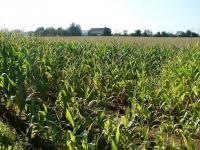-
Bringing energy prices down and keeping the lights on
Peak demand is posing an increasing challenge to the U.K.’s electricity system. Researchers at the University of Oxford have launched a five-year program to investigate ways of relieving peak demands on the U.K.’s electricity grid that also might make energy bills cheaper too.
-
-
Mapping Louisiana’s water flow interactions to preserve state’s fresh water

As part of an effort to preserve Louisiana’s fresh water resources, RTI International worked with The Nature Conservancy (TNC) to develop two online tools, released today, that offer a first-of-their-kind look at how Louisiana’s waters interact with each other. These tools will help fishermen, oystermen, planners, decision makers, and all Louisianans understand the state’s unique water flow patterns.
-
-
Water 4.0—the next revolution in urban water systems
In his 2014 book, Water 4.0, UC Berkeley environmental engineer David Sedlak identifies four “revolutions” in the development of urban water systems. Sedlak says that we need a fourth revolution now. Soaring urban populations and a changing climate create chronic water shortages in some cities and too much water in others. Some contaminants may pose hazards in extraordinarily small concentrations. And aging pipe networks threaten the health of entire communities, as seen this year in Flint, Michigan.
-
-
Raccoon brings down grid, cutting power to 40,000 Seattle homes
A raccoon broke into a Seattle, Washington power substation on Wednesday morning and single-handedly (some suggest: single-pawedly) brought down the electrical grid, cutting power to more about 40,000 homes. The raccoon did not stay inside the substation for long, but still managed to cause thirteen separate system outages.
-
-
Building security into cyber-physical systems
We are immersed in a cyber-physical world. Information technology is deeply embedded in traditionally non-IT systems, including automobiles, the electric grid and emergency response. But in many of these systems, security is largely incorporated as a last step, like a suit of armor over a vulnerable body. To help bake security into the very core, a new draft NIST publication recommends ways to incorporate time-tested security design principles and concepts into these systems at every step, from concept to implementation.
-
-
Growing demand for bioenergy threatens global food supply

As countries around the world look for ways to reduce their use of fossil fuels, the growing demand for bioenergy runs the risk of threatening the global food supply. Researchers have developed a certification scheme for biomass resources designed to incorporate food security, to help ensure people in affected regions of the world can continue to put food on their tables.
-
-
Governor Brown issues order to continue water savings as drought persists
Moving to bolster California’s climate and drought resilience, Governor Edmund G. Brown Jr. the other day issued an executive order that builds on temporary statewide emergency water restrictions to establish longer-term water conservation measures. The governor’s office says that Californians have responded to the call to conserve water during the drought by dialing back sprinklers, replacing lawns, fixing leaky faucets, and installing more efficient toilets and washing machines. Between June 2015 and March 2016, Californians reduced water use by 23.9 percent compared with the same months in 2013 — saving enough water to provide 6.5 million Californians with water for one year.
-
-
Floods, coastal erosion may expose contents of UK landfills
The contents of historic coastal landfill sites in England and Wales could pose a significant environmental threat if they erode, according to a new study. The main risks to these landfills come from the effects of climate change, including erosion and flooding with salt water from storm surges and higher water levels.
-
-
Mapping water use of America’s water resources
Water is one of our nation’s most important natural resources, one that is long been considered inexhaustible. Yet changes in land use, climate, and population demographics are placing unprecedented demands on America’s water supplies. As droughts rage and aquifers dwindle, people may wonder: Is there enough water to meet all our needs?
-
-
Marine Corps, Sandia collaborate on microgrids and renewable energy planning
The U.S. Marine Corps are the first boots on the ground in a crisis. On the front lines, they must be able to power up securely without plugging into utilities. They require nothing less than completely reliable and cost-effective energy independence. Researchers from Sandia National Laboratories are collaborating with the Marine Corps to increase their energy security and reduce fuel dependence through alternative technologies, including renewable energy and microgrids.
-
-
Protecting Texas electrical grid key to preserving national security
Protecting America’s most vulnerable asset – our electric power grid – starts with Texas, according to a new study. “As Texas goes, so goes our national security,” says the study’s author. “Outside of California and the Beltway, Texas is arguably the most important state for defense readiness.” Hardening the state’s electric power grid should be top priority.
-
-
“Internet of Things” increases threat to infrastructure
According to former Director of National Intelligence Dennis Blair, a simple Web search can reveal information from thousands of unsecured devices. Even the casual browser can access camera data from Sweden, video game server activity in Eastern Europe, or the output of American wind turbines. He said this information is as easily accessible to terrorists and other criminals. And more will become available as the “Internet of things” — the collection of physical systems and devices connected to the Internet — grows in size.
-
-
Climate-driven water scarcity could reduce economic growth by up to 6%: World Bank
Water scarcity, exacerbated by climate change, could cost some regions up to 6 percent of their GDP, spur migration, and spark conflict, according to a new World Bank report released the other day. The report says the combined effects of growing populations, rising incomes, and expanding cities will see demand for water rising exponentially, while supply becomes more erratic and uncertain.
-
-
Fixing NYC’s aging infrastructure one engineering problem at a time
How do you make sure aging bridges which are vital links in New York City’s transportation network are safe or keep the city’s sewer system from breaking down? These are among the questions that occupy Columbia University researchers, who have installed sensors to analyze vibration on some of the city’s bridges and in landmark buildings and museums, and have focused on the functioning of the city’s water system.
-
-
More corrosion-resistant water pipes could preventing another Flint, Mich. health crisis
Corrosion-related damage costs more than three percent of the United States’ Gross Domestic Product (about $503.1 billion, going by 2013 numbers). With documented public water problems in Flint, Michigan, and Hoosick Falls, New York, caused by corrosion, understanding how copper is affected at the atomic level is critical to avoiding problems in future pipes.
-
- All
- Regional
- Water
- Biometrics
- Borders/Immig
- Business
- Cybersecurity
- Detection
- Disasters
- Government
- Infrastructure
- International
- Public health
- Public Safety
- Communication interoperabillity
- Emergency services
- Emergency medical services
- Fire
- First response
- IEDs
- Law Enforcement
- Law Enforcement Technology
- Military technology
- Nonlethal weapons
- Nuclear weapons
- Personal protection equipment
- Police
- Notification /alert systems
- Situational awareness
- Weapons systems
- Sci-Tech
- Sector Reports
- Surveillance
- Transportation
Advertising & Marketing: advertise@newswirepubs.com
Editorial: editor@newswirepubs.com
General: info@newswirepubs.com
2010-2011 © News Wire Publications, LLC News Wire Publications, LLC
220 Old Country Road | Suite 200 | Mineola | New York | 11501
Permissions and Policies
Editorial: editor@newswirepubs.com
General: info@newswirepubs.com
2010-2011 © News Wire Publications, LLC News Wire Publications, LLC
220 Old Country Road | Suite 200 | Mineola | New York | 11501
Permissions and Policies
